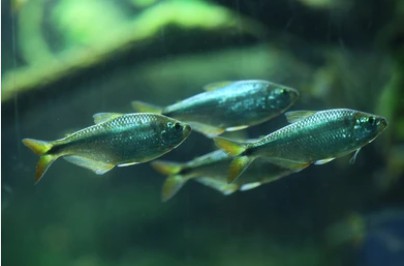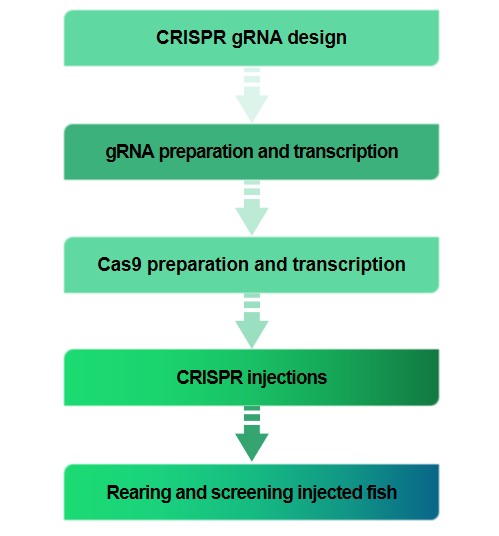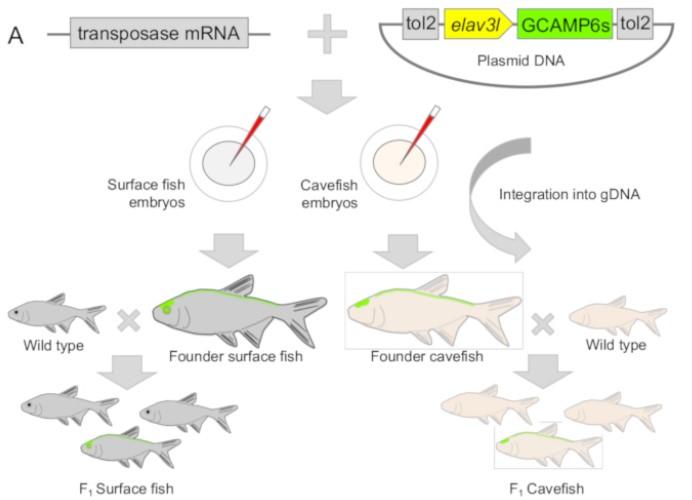Astyanax mexicanus (A. mexicanus), also known as Mexican tetra and Mexican cavefish, is a member of the Characiformes, Characidae, and Astyanax. One is a surface type with normal eyes and body coloration. The other is a burrowing type derived from the surface type, showing absent eyes and albino body coloration, mainly in cave waters.
 Figure 1. Mexican tetra (Astyanax mexicanus) is the blind cavefish.
Figure 1. Mexican tetra (Astyanax mexicanus) is the blind cavefish.
A. mexicanus has high ornamental value and is a rare ornamental fish. With the development of sequencing technology, scientists have obtained high-quality A. mexicanus genome data. More importantly, A. mexicanus, as a cave animal, is the best animal model for studying the evolutionary mechanisms and genetic basis of adaptive changes, which include eye degeneration, albinism, and sensory processing, among others. Also, the wide range of natural craniofacial morphology observed in A. mexicanus allows A. mexicanus to be used as an animal model for studying human congenital and metabolic skeletal disorders.
As a professional fish gene editing technology service provider, Lifeasible can provide you with four types of gene editing services, including CRISPR/Cas9, morpholinos, and Tol2 transposons to knock out candidate genes for biological evolution and explore the adaptation mechanism of cavefish to their environment.
CRISPR-Cas9 is currently the simplest, most versatile, and most precise method for genetic manipulation. We used CRISPR-Cas9 technology to modify the Oca2 gene locus, targeting CRISPR to introduce a 2 bp deletion, disrupting Oca2-function. Then, it was injected into the A. mexicanus cell line by microinjection, and the exogenous target gene was successfully integrated and expressed, and A. mexicanus with albinism was constructed.
 Figure 2. Flow chart of CRISPR/Cas9 technology services.
Figure 2. Flow chart of CRISPR/Cas9 technology services.
Morpholino is a stable synthetic nucleic acid analog that binds to specific target sites through complementary base pairing, blocking protein translation or mRNA splicing, resulting in reduced or absent protein products. In A. mexicanus, we can successfully construct mutant fish with reduced activity and increased sleep by knockdown Hcrt by this simple and effective reverse genetic method.
 Figure 3. Flow chart of Morpholino knockdown technology services.
Figure 3. Flow chart of Morpholino knockdown technology services.
Tol2 is a very active transposon system that can insert foreign DNA into the genome of host cells very efficiently. We use plasmid transfection or electroporation to permanently integrate your gene of interest into the host genome. For example, we combined the Tol2-elav3l: GCAMP6s-Tol2 plasmid into the genome of A. mexicanus to explore the relationship between brain-wide differences in neuronal activity and behavioral differences to understand brain evolution.
 Figure 4 . Flow chart of Tol2 transgene technology services. (Stahl, B. A, et al. 2019)
Figure 4 . Flow chart of Tol2 transgene technology services. (Stahl, B. A, et al. 2019)
Lifeasible's advanced gene editing technology platform for A. mexicanus also can be applied to most Mexican cavefish populations. We will do our best to provide you with accurate and efficient gene editing services to broaden your research in gene function. For more information or any inquiry request, please contact us.
References